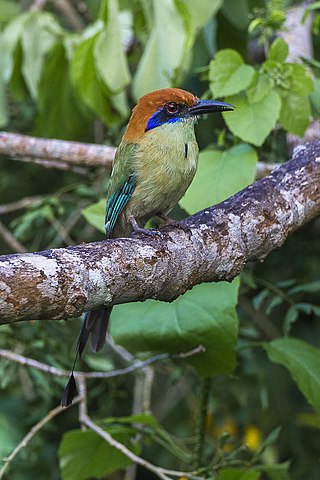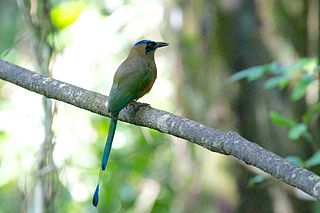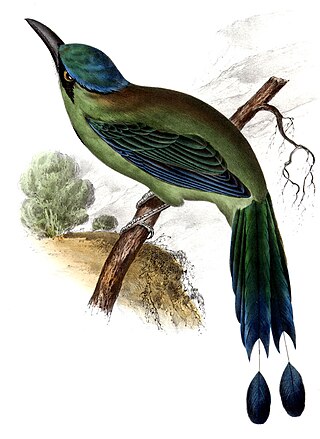
The Amazonian motmot is a colorful near-passerine bird in the family Momotidae. It is found in the Amazon lowlands and low Andean foothills from eastern Venezuela to eastern Brazil and northeastern Argentina.

The crimson-collared tanager is a rather small Middle American songbird. It was first described by the French naturalist René-Primevère Lesson in 1831, its specific epithet from the Latin adjective sanguinolentus, "bloodied", referring to its red plumage.

Momotus is a small genus of the motmots, a family of near passerine birds found in forest and woodland of the Neotropics. They have a colourful plumage, which is green on the back becoming blue on the flight feathers and the long tails. The barbs near the ends of the two longest central tail feathers fall off, leaving a length of bare shaft so that tails appear racket-shaped.

The turquoise-browed motmot is a colourful, medium-sized bird of the motmot family, Momotidae. It inhabits Central America from south-east Mexico, to Costa Rica, where it is common and not considered threatened. It lives in fairly open habitats such as forest edge, gallery forest and scrubland. It is more conspicuous than other motmots, often perching in the open on wires and fences. From these perches it scans for prey, such as insects and small reptiles. White eggs (3–6) are laid in a long tunnel nest in an earth bank or sometimes in a quarry or fresh-water well. Its name originates from the turquoise color of its brow. It is the national bird of both El Salvador and Nicaragua, where it is known as torogoz and guardabarranco respectively.

The rufous motmot is a near-passerine bird in the family Momotidae. It is found from northeastern Honduras south to western Ecuador, northern Bolivia, and western Brazil.

The blue-throated motmot is a species of bird in the family Momotidae. It is found in El Salvador, Guatemala, Honduras, and Mexico.

The keel-billed motmot is a species of bird in the motmot family Momotidae. It is very closely related to the broad-billed motmot, and the two may be the same species. The two are similar sizes and shapes, and have been reported to have similar calls, but they do have different plumage.

The broad-billed motmot is a fairly common Central and South American bird of the Momotidae family. They are nonmigratory, sedentary birds that are most frequently seen in singles or pairs. There exist six subspecies of the broad-billed motmot.

The tody motmot is a species of passerine bird in the motmot family Momotidae. It is the only species placed in the genus Hylomanes. It is found in Belize, Colombia, Costa Rica, El Salvador, Guatemala, Honduras, Mexico, Nicaragua, and Panama.

The russet-crowned motmot is a species of motmot native to north-western Mexico and central Guatemala. It is a year-round resident of the tropical and subtropical dry broadleaf forests and scrubland. The russet-crowned motmot is the most understudied species of motmot in the family Momotidae.

The Veracruz moist forests is a tropical moist broadleaf forests ecoregion in eastern Mexico.

Soberanía National Park is a national park in Panama near the banks of the Panama Canal in the provinces of Panamá and Colón, some 25 kilometres (16 mi) from Panama City. The Chagres River runs through the park. Established as a national park in 1980, the park covers 55,000 acres (220 km2).

Saltinho Biological Reserve is a Biological Reserve near Tamandaré in the state of Pernambuco, Brazil. It contains a sample of the tropical Atlantic Forest biome.

The gartered trogon, also known as the northern violaceous trogon, is a bird in the family Trogonidae, the quetzals and trogons. It is found in Mexico, all of Central America, and Colombia, Ecuador, Peru, and Venezuela.

The whooping motmot is a colorful near-passerine bird in the family Momotidae. It is found in Colombia, Ecuador, Panama, Peru, and Venezuela.

The Trinidad motmot is a colorful near-passerine bird endemic to the forests and woodlands of Trinidad and Tobago. This species and the blue-capped motmot, Lesson's motmot, whooping motmot, Amazonian motmot, and Andean motmot were all considered conspecific. Though found on both islands, this bird is more abundant in Tobago than it is in Trinidad.

The Andean motmot or highland motmot is a colorful near-passerine bird found from northern Colombia to western Bolivia.
Cymbopetalum mayanum is a species of plant in family Annonaceae. The specific epithet mayanum refers to the Mayan region in which it is indigenous, specifically the Atlantic lowlands of Guatemala and Honduras. It grows as a tree. It is endangered due to habitat loss from agriculture.

The blue-capped motmot or blue-crowned motmot is a colorful near-passerine bird found in forests and woodlands of eastern Mexico. This species and the Lesson's Motmot, Whooping Motmot, Trinidad Motmot, Amazonian Motmot, and Andean Motmot were all considered conspecific. The IUCN uses blue-crowned as their identifier for this species; however, it was also the name used for the prior species complex.

La Primavera Biosphere Reserve, also known as La Primavera Flora and Fauna Protection Area, is a protected natural area in western Mexico. It is located in the state of Jalisco, immediately west of the city of Guadalajara.






















